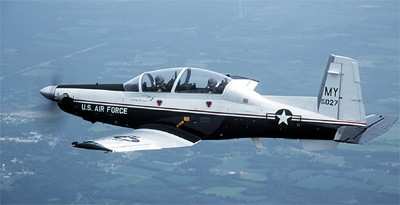Will Increase Maintenance On Oxygen Distribution Systems On T-6 Texan Airplanes
The Air Force will begin implementing a series of corrective measures, including redesigning the oxygen system and adjusting oxygen control levels in flight, to address persistent problems in training aircraft. In addition, Air Education and Training Command will increase maintenance on the oxygen distribution system, known as OBOGS, to curb problems identified in T-6 Texan II trainer aircraft.

The measures came after a six-month examination of problems with the system by AETC and Air Force Material Command looking into fluctuating oxygen levels for pilots. A team of experts, including the Navy and NASA, have worked together to improve pilot safety and reduce physiological events in flight.
Varying levels of oxygen concentrations in the cockpit was identified as the major factor in unexplained physiological events that affected T-6 pilots across AETC.
“So far, technical efforts to date and analysis of data collected have determined that pilots have been exposed to significantly changing levels of oxygen concentration,” said Lt. Gen. Steve Kwast, AETC commander. “The varying levels of oxygen concentration, even though in excess of what the body typically needs, has caused physiological stress that most pilots on most days actually adapt to without noticing.”
The physiological stress results in symptoms that can be similar to hypoxia, or lack of oxygen, hypocapnea, or lack of carbon dioxide, or other related conditions, Kwast said.
In February 2018, Maj. Gen. Patrick Doherty, 19th Air Force commander, directed an operational pause for pilots across the T-6 fleet. At the same time, AFMC stood up an independent review team to investigate potential causes, working with AETC to conduct a full inspection of the T-6 OBOGS. During the pause, AETC and AFMC conducted multiple inspections. During those inspections, the OBOGS filter and drain valves were found to fail at a much higher than anticipated rate. These parts were repaired or replaced as necessary.
Because some oxygen system components were failing at higher than expected rates, the T-6 Program Office at Tinker Air Force Base, Oklahoma, directed inspections on a more aggressive timeline.
In a process expected to take between two and four years, AETC, in partnership with AFMC, has initiated a redesign of the T-6 OBOGS system to stabilize the variation in the percentage of oxygen levels pilots breathe. Concurrently, AETC and AFMC are working with the aircraft manufacturer to adjust the OBOGS software algorithm to stabilize oxygen concentrations. While this should reduce physiological events, the Air Force will pursue a broader redesign.
The Air Force will also introduce new maintenance procedures drawn from several different Air Force and Navy T-6 bases. For example, purging excess moisture from the system appears to keep the OBOGS operating more efficiently over time, Doherty said.
Brig. Gen. Edward L. Vaughan, Air Force Physiological Episodes Action Team lead, plans to collaborate with Air Force officials and other military services to determine if the OBOGS measures planned for the T-6 will be applicable across other aircraft that use OBOGS.
AETC officials are also adding study materials for T-6 pilots. The training will focus on identifying symptoms, responses and corrective procedures for all types of events, not just hypoxia.
“Since our T-6 operational pause, we have made every effort to communicate with every instructor and every student exactly what we’ve found,” Doherty said. “Transparency remains of utmost importance to use as we all work together to ensure that our pilots are safe and know the way ahead.”
(Source: USAF news release. Image from file)
 Bolen Gives Congress a Rare Thumbs-Up
Bolen Gives Congress a Rare Thumbs-Up The SportPlane Resource Guide RETURNS!!!!
The SportPlane Resource Guide RETURNS!!!! Buying Sprees Continue: Textron eAviation Takes On Amazilia Aerospace
Buying Sprees Continue: Textron eAviation Takes On Amazilia Aerospace Hawker 4000 Bizjets Gain Nav System, Data Link STC
Hawker 4000 Bizjets Gain Nav System, Data Link STC Echodyne Gets BVLOS Waiver for AiRanger Aircraft
Echodyne Gets BVLOS Waiver for AiRanger Aircraft



